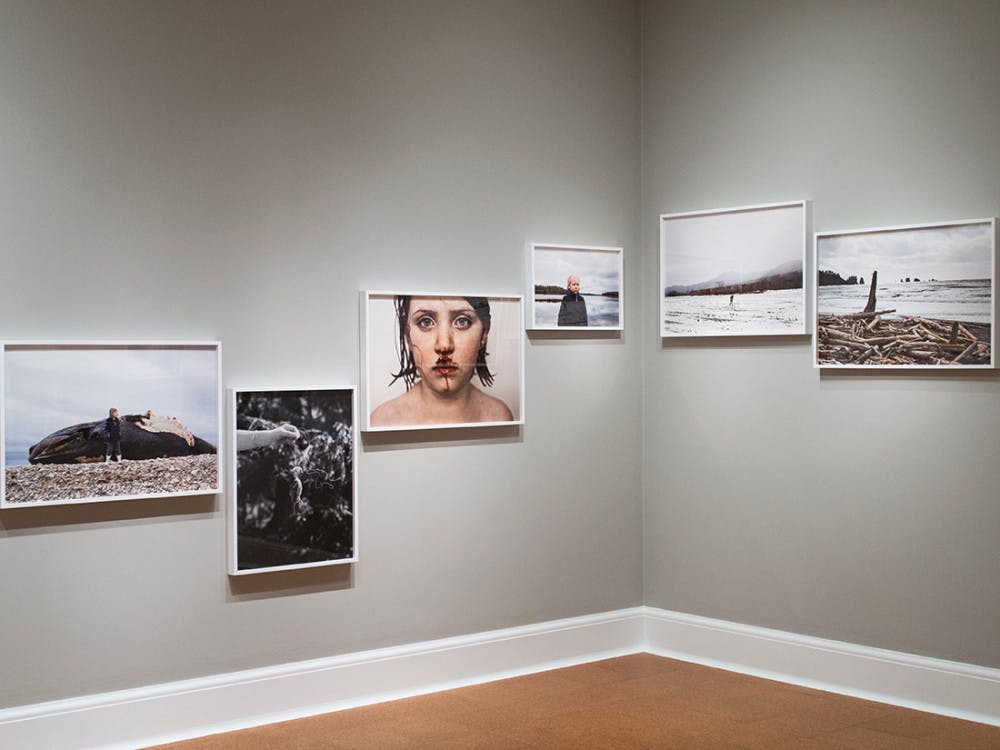Three new exhibits opened at the Rhode Island School of Design Museum Jan. 22 — “Drawing Conclusions,” “Wild and Precious” and “Swagged and Poufed: The Upholstered Body in the Late 19th Century and Today.”
“Drawing Conclusions,” which can be found in The Linda and Vincent Buonanno Works on Paper Gallery, features prints, photographs, paintings and drawings from various artists including Larry Day, Marcel Dzama, Faith Ringgold and Kara Walker. A key component of the exhibit is the diversity of the pieces, particularly in their narratives and respective artists. It was organized by two assistants in the museum’s Department of Prints, Drawings and Photographs, Emilia Mickevicius GS and Jagdeep Raina, an MFA candidate at RISD.
“We wanted to create an intimately scaled, thematic exhibit that showed off recent acquisitions and works that haven’t been on view in a while from a diverse group of artists the public might not have heard of before,” Mickevicius said. Some of the artists, such as Walker, are RISD alums.
“We wanted to show how works of art stage encounters between themselves and their viewers and direct our attention in certain ways,” Mickevicius said. “All of the works revolve around the theme of narrative and how works set themselves to be read.”
Mickevicius noted that as the title of the exhibit suggests, viewers draw their own conclusions about each piece. The exhibit speaks to the different types of narratives art can convey — from social and political to surreal and fantastical.
“Narrative can take many different forms in contemporary art — works of art don’t have fixed, inherent meanings,” she said, adding that the meaning of art is a product of the artist’s intentions and the viewer’s interpretation.
“Wild and Precious,” at the Tsiaras Photography Gallery, is an exhibition of several photographs taken by Jesse Burke, an adjunct photography professor at RISD, over the last five years while he travelled across the United States with his daughter, Clover. The photographs showcase her interacting with nature. Some photos depict her standing on rocky cliffs; in others, she naps among animals.
Burke came up with the idea for his photography project when Clover, his first child, was born.
“We’re a nature-inspired family,” he said. “We like to be outside and connected to the animal world, and we hoped our first child would adopt this same lifestyle.”
Burke added that he wanted to create a sense of responsibility and connection to nature through the project. It took about eight months to mount the museum exhibition, Burke said, noting that the photographs included are only a small, carefully selected sample.
“I created this work in pieces, traveling around and essentially collecting and creating data. This exhibition is an organized layout of the data,” he said. “It serves as a final resting place for the work in an idealized state — how I would ideally have you experience the pieces.”
Burke added that the layout of the installation should push viewers to do a self-guided tour of the space by “walking back and forth, left and right, so you’re sort of experiencing what my daughter and I experienced when we were out on the road.” The goal of the installation is to help transport the viewer into the same space and mindset he and his daughter were in when visiting these different places, he said.
Burke noted that photography is his favorite medium because it is an effective way to convey a message. “The most important part of art-making practice is that you have an understanding of the concepts and ideas that are most interesting to you,” he said.
The exhibit “Swagged and Poufed: The Upholstered Body in the Late 19th Century and Today,” at the Angelo Donghia Costume and Textiles Gallery, features women’s clothing from the past and present that shares aesthetics with upholstered furnishing styles of the late 1800s. The contemporary fashion pieces emulate overlapping trends in 19th century women’s fashion and interior design. A center case in the gallery presents dresses, mantles, rugs and a carpetbag from the time period alongside contemporary fashions that bear similar designs, and a three-minute film accompanies the exhibit.
The late 19th century pieces bear an “upholstered look” that “represents a time when there was much emphasis on textiles both for the interior and on the body,” said Kate Irvin, curator of costume and textiles for the RISD Museum. The quality, layering and elaborate manipulations of textiles for furnishings and fashion demonstrated a woman’s “personal refinement,” she said.
The preoccupation with textiles was tied to the Industrial Revolution and the far reach of empire during this period, she said. “Upper-class women spent much of their social life within the confines of the drawing room — nearly becoming one with the drawing room — though the soft furnishings of her interior and the fashions worn on her body made explicit reference to the riches and reach of colonialist enterprises during this period,” she said.
All three exhibits will run throughout the spring semester.





